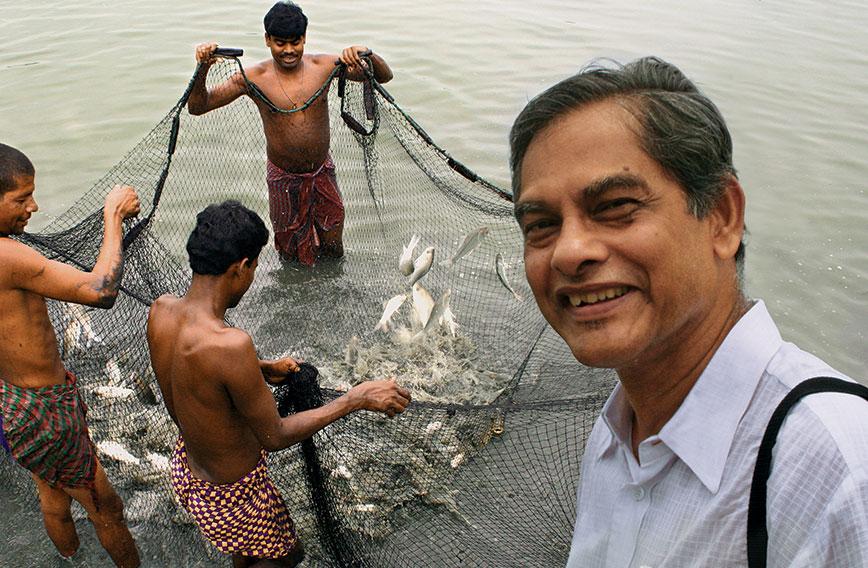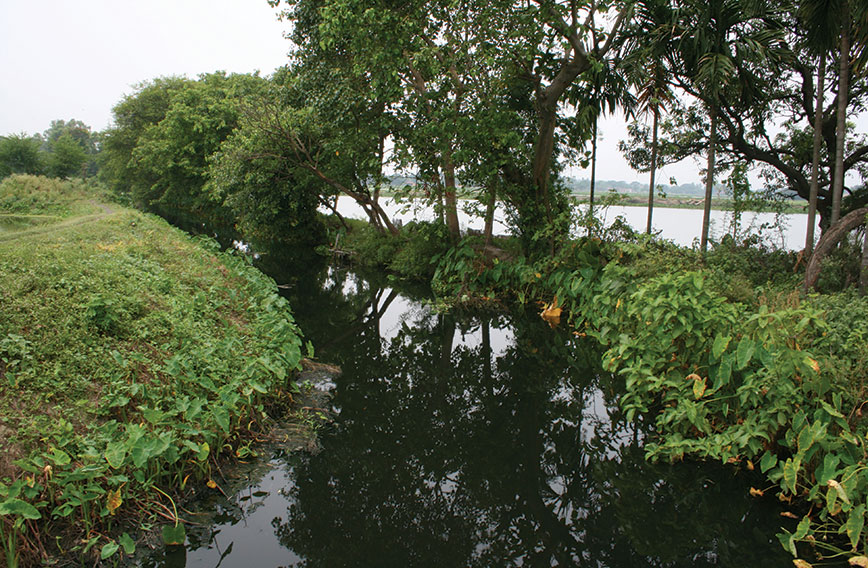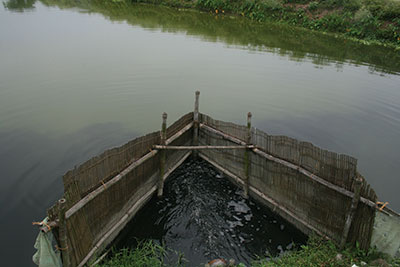
Dhrubajyoti Ghosh
If the magical East Calcutta Wetlands are surviving, in whatever truncated form, the credit should to Dr Dhrubajyoti Ghosh, who passed away last year. For more than three decades he tirelessly campaigned for the wetlands to be recognised as a priceless resource recycling system - taking waste from the city in the form of sewage and giving back food in the form of fish and vegetables.
When he took up this cause, he was a civil engineer in the Public Works Department. For someone on that dry and constricting perch, he surprisingly also saw the world in its many complexities. Visiting the wetlands extensively, he unravelled their value as he went from fishery to garbage garden. For him, theory was all about practice. In east Calcutta he immersed himself in the science of a traditional system.
Civil Society has tracked Dr Ghosh's work over the years. Below is the cover story featuring him in the July 2008 edition. Read on.
Each day Indian rivers come under assault as cities big and small across the country disgorge sewage into them. The Yamuna has been reduced to a drain as it trickles past Delhi. The mighty Ganga is no better than a cesspool at many locations on its long course. The stories of a whole lot of other rivers are no better.
Since the eighties, huge sums of public money have been spent on trying to put an end to this pollution. Under dedicated action plans, sewage treatment plants have been set up, but they either have little efficiency or lie in complete disuse. Often, there just isn’t the electricity to run them. Moreover, municipal administrations are so lacking in accountability that treatment plants really have no ownership.
However, for the past 70 years or so, in the eastern fringes of Kolkata, a network of ponds managed by local people has been able to achieve what government initiatives have not. Untreated sewage flows into the ponds and is cleansed at one-third the cost of a treatment plant. The sewage is used to grow fish, irrigate fields and finally, minus its original contaminants, it flows into the Kulti Gong.
Kolkata’s sewage, estimated at 750 million litres a day, goes through underground sewers to points from where it is pumped into outfall canals that take it into the eastern wetlands. These wetlands are an extension of Kolkata’s drainage system beyond the sluice gates en route to the river.
The ponds here serve the dual purpose of naturally treating sewage and reusing waste. They have been globally recognised as a flourishing resource recycling system based on traditional knowledge and practices. The ponds provide a unique solution to concerns over urban ecological balance. They have a special position in a world that wakes up each day to new worries over energy, waste, livelihoods and food.
The system is scientific, but for decades it has worked on knowledge of its intricacies being passed on from one generation to the next.
When the sewage arrives in the pond network, it is kept standing in the sun, which results in biodegradation of the wastes through an algae- bacteria symbiosis. The local people have got this process right. They know to excavate the ponds to the correct depth, take in the right quantity of sewage and then judge when it is ready to be used for safely growing fish.
Pond design is important. So is the use of water hyacinth to absorb heavy metals in the sewage and serve as a buffer for the sides of the ponds.
 When the managers of the ponds are through with purifying the sewage, the biochemical oxygen demand (BOD), a measure of organic pollution, has been reduced by more than 80 per cent. Also, almost all coliform bacteria have been removed.
When the managers of the ponds are through with purifying the sewage, the biochemical oxygen demand (BOD), a measure of organic pollution, has been reduced by more than 80 per cent. Also, almost all coliform bacteria have been removed.
The wetlands consist of fisheries, paddy fields that use effluents from the fisheries and vegetable garbage gardens.
An average pond can produce as much as 5 tonnes of fish in a year. The species are Rohu, Catla, Mrigal and Tilapia. The ponds are believed to support 8,500 people directly. But they provide a much bigger service to Kolkata by ensuring a regular supply of fish to the city’s markets, serving as a carbon sink with their greenery and water bodies and in addition they cleanse the city’s sewage.
The wetlands were originally used for growing brackish water fish. But when the Baidyadhari, which brought in sea water, died it became necessary to find an alternative source of water. It was then that local people experimented with waste from Kolkata leading to a whole new expertise in growing fish.
This and more is known about the system because of the efforts of Dhrubajyoti Ghosh, an engineer-ecologist, who while employed in the West Bengal government in the eighties researched the system and showcased its benefits.
“For a planner, it is difficult to identify an alternative concept that can be less capital intensive than the Kolkata wetland system. It has been functioning for ages in harmony with nature,” says Ghosh.
Describing Ghosh as “one of the world’s leading ecologists,” MS Swaminathan, the internationally famous agricultural expert, says: “In the east Kolkata wetlands, the local people have created the world’s largest assembly of waste water fish ponds. This is an excellent demonstration of traditional ecological prudence which leads to converting waste into a valuable resource.”
East Kolkata has found recognition in very diverse quarters. It is hailed by ecologists and environmentalists. It is included in a World Bank handbook on ecosystem management. The ponds are also collectively listed as a wetland to be preserved under the Ramsar Convention.
East Kolkata has found mention in the national environment policy. Recognition of the role played by its ponds in cleansing sewage also led them to be included in the Ganga Action Plan as a viable low-cost alternative technology. Three sites elsewhere in West Bengal were chosen for replication, in addition to some interest shown in Uttar Pradesh.
At each of these sites, Ghosh demonstrated that an east-Kolkata type system could work. The pollution load was reduced to levels required under the Ganga Action Plan. The ponds produced fish. And the cost of setting up the system was barely a third of what it would have been for a conventional sewage treatment plant.
But for all this validation, there has been little serious effort to examine how the east Kolkata system can be protected and perpetuated. No significant effort has been made to reinvent the system elsewhere in India as a workable solution to the problem of filthy rivers.
Can, for instance, ponds like the ones in Kolkata be made to work on the banks of the Yamuna in Delhi? Are they any good for the outfalls that serve rapidly expanding urban areas of Gurgaon in Haryana?
 Possible hurdles could be cultural in nature. Not everyone eats fish and many actually turn up their noses at its smell. Then again, sewage is widely regarded as being dirty. Perhaps it is too much to expect communities to overnight acquire the decades-old conditioning of the people of east Kolkata.
Possible hurdles could be cultural in nature. Not everyone eats fish and many actually turn up their noses at its smell. Then again, sewage is widely regarded as being dirty. Perhaps it is too much to expect communities to overnight acquire the decades-old conditioning of the people of east Kolkata.
There is also the problem of having enough land. Several thousand hectares would be needed. A natural gradient in the topography, too, is required. Kolkata slopes gently from the west to the east and the drainage system of the city follows this gradient.
Toxicity is another serious concern. With municipal administration becoming slack there is a growing danger of chemicals and other industrial wastes getting mixed up with the sewage. This has serious implications for the fish and agricultural produce from the wetlands. So far studies conducted in east Kolkata have shown that the contamination is not significant. Better urban management can ensure that industrial wastes do not mingle with the sewage.
Adaptations of the east Kolkata model are a serious option. A little innovation in government has been seen to work wonders. Educating communities and giving them the incentives to use innovative solutions can go a long way. This may be particularly so in times when communities feel oppressed by pollution and water shortages.
It is well known that farmers are ever-eager to take nutrient rich effluents from sewage treatment plants, where and when they are in working condition. They realise they are taking cleansed sewage. So, a possible mental block against sewage as a resource isn’t an insurmountable problem where a tradition, as the one in east Kolkata, may not already exist.
Similarly, state governments in regions far removed from the culture of eating fish have been encouraging fish cultivation with grand success, thereby providing local prosperity through small businesses and jobs and an important source of protein. Haryana is an example with a fish farmer in Karnal getting a national award for entrepreneurship.
Perhaps East Kolkata’s biggest asset, which is its innate simplicity, is its real undoing. Policy-makers find it hard to make the transition from a regime of tenders and purchase orders to a lithe, people-based, low-cost system that is truly entrepreneurial in spirit and managed without government interventions.
The east Kolkata wetlands have been under attack in Kolkata itself for the past two decades despite the service they provide the city and their unique resource recycling role.
With Kolkata being congested and over-built, developers and land sharks have looked to the eastern periphery, which runs adjacent to the city, for expansion.
These are forces that have a huge influence over policy. The result has been the steady whittling away of the hinterland of the ponds over the years. Housing colonies, industrial estates, hotels, expanding roadways and so on have eaten into the east.
The entire resource recycling system, which includes agricultural fields, garbage gardens, channels and so on, now consists of some 8,500 hectares of which the ponds represent 4,000 hectares.
This is protected under the Ramsar Convention. But international protection on paper can mean a lot and nothing at all. In the absence of adequate local government and political recognition of the worth of the system, east Kolkata is foundering. Property developers keep attempting forays of one kind or the other into the wetlands with the state CPI (M)-led Left Front government looking the other way because of the interests involved.
Fish pond owners are also constantly at the mercy of the municipal authorities over the availability of sewage, which must reach their ponds through designated channels. Maintenance of the channels is also required.
A big challenge is in maintaining continuity. The younger generation feels insecure about the future and is therefore an unwilling inheritor of the system. So far the science in managing the fish ponds has been passed on from one generation to the next. But the older people who know how the system works are fading out and the young are hesitant to come forward.
TWO SYSTEMS: In the conventional system of waste water treatment, reducing pollution is the sole objective. In the wetlands, the quality of the water released into the river is improved, but resource recovery is an integral part of the exercise. So while the wetlands help in keeping the river clean, they also seek to provide food and livelihoods.
The 5 tonnes of fish per hectare per year that a well-managed pond delivers is not insignificant. The fish goes back to the city of Kolkata as food. On the other hand in the conventional system, assuming that it works to optimum levels, only the sewage is treated before it flows into the river.
The key difference between the two systems is that one sees waste water as a pollutant and the other as a resource.
Since local people benefit from the traditional system, they develop a keen interest in making the system work. The farmer gets nutrient rich water for irrigation and fish production provides livelihoods. But a mechanically run treatment plant has few owners. So, when it shuts down, no one really cares.
In the pond system, failure to perform will affect irrigation downstream. It is most likely farmers will protest at being deprived of their water. Then again, if the ponds are not properly maintained, fish production will suffer and the profits of the fish producers will be hit.
The wetlands of east Kolkata have been kept alive by people who depend upon them. If they have worked well it is because the community ensures that they do.
Another point is the flexibility of the traditional system. It can be expanded as you go along. On the other hand a sewage treatment plant is designed for the next 20 years and even after 10 years 30 per cent of the capacity of these plants is not being used.
LITTLE KNOWN: Little or nothing was known about east Kolkata till the eighties. It is only when Ghosh began studying the system and promoting it as a waste-as-resource example that awareness grew.
For most of Kolkata’s residents, the city ended at the tanneries on the eastern fringes. The Dhapa square mile where vegetables are grown on garbage from the city, the sewage fed fisheries and the agricultural fields simply did not exist.
The Eastern Metropolitan Bypass, skirting Kolkata and providing easy access to the airport, brought the city closer. But even then east Kolkata was chiefly known for the strong smell of wastes that Kolkatans would get while driving past. There would also be mountains of garbage at the landfill sites --- a reminder of the pressures building on Kolkata’s civic services.
Of the resource recycling system beyond, there was no awareness. There is slightly wider knowledge today of its working, but it is mostly academic. Ghosh’s single-minded devotion to the system has resulted in some media coverage. However, the best stories were done in the eighties and coincided with Ghosh being able to bond with journalists sensitive to his ideas.
Thereafter, Ghosh, despite international recognition, got pushed around in government for coming in the way of interests who saw in east Kolkata a real estate opportunity. Likewise journalists willing to explore the fisheries and understand the science in them moved on.
There has been the odd effort in the courts to save the wetlands. Bringing them under the Ramsar Covention, of course, does the maximum to protect them. An outstanding documentary film by Jojo Karlekar and his team, the recipient of awards and once aired on Doordarshan, will preserve for posterity the life around the wetlands.
But for the average Kolkatan the city still ends at the Bypass and the housing colonies and offices and so on that have come up along it.
Getting to know the wetlands means leaving the bypass and taking the road to Bantala for instance. An hour down that road you will find expanses of fisheries. The air is fresh and free from the heavy diesel fumes that hang over Kolkata. On a clear day you can see the buildings of the city. Nevertheless the setting is entirely rural.
Fishermen are out in their boats, bringing in a catch. There are others tending to nets or transferring fries from small ponds to big ones. There are machaan-like platforms for keeping watch over the ponds which get raided by marauders. Packs of dogs do guard duty all night and laze around during the day.
The area around the ponds is hugely fertile. Pond-managers grow vegetables in plenty and flowers too. Ducks are a part of this ecosystem. It is their job to get rid of snails that aren’t good for the ponds.
NO MANAGEMENT PLAN: Ghosh believes that the wetlands continue to suffer from the lack of a management plan and the absence of ownership of the system in the municipal administration. “The danger is we don’t have a management plan for the wetlands as yet even after five years of it being declared a Ramsar site. But governance is urgently needed,” he says.
On the question of ownership, he says, the Kolkata Municipal Corporation (KMC) often pleads inability in maintaining the height of waste water at nine feet at Bantala. The pumping department does not want to cooperate.
Ghosh argues that thanks to the wetlands the KMC saves Rs 600 crores, which it would have had to spend on setting up a sewage treatment plant. It should therefore exercise ownership over the wetlands and do its best to help them flourish.
“The technology used here is not magic. It is well understood and recognized by sanitation engineers. Oxidation is one of the best methods of cleansing sewage,” he explains.
Ghosh considers it possible to replicate the system in any wetland area even if it is not as big an expanse as Kolkata’s wetlands. “Land won’t be a problem if the wetlands are regarded as part of an agricultural system,” he says.
That is as much a solution as it is a problem. Initiatives that don’t involve acquiring land and issuing contracts have few takers in the government.
But Ghosh believes that despite the neglect of east Kolkata in India, its moment in a new set of global priorities has arrived. “The fishermen of the wetlands are the forerunners of a contemporary world view of waste as resource pursued by leaders and thinkers of the modern-day environment movement,” he says. And in a shrinking world, saving east Kolkata and replicating may well yet become an Indian priority.
Comments
Currently there are no Comments. Be first to write a comment!



